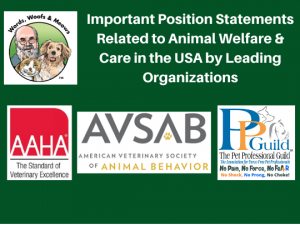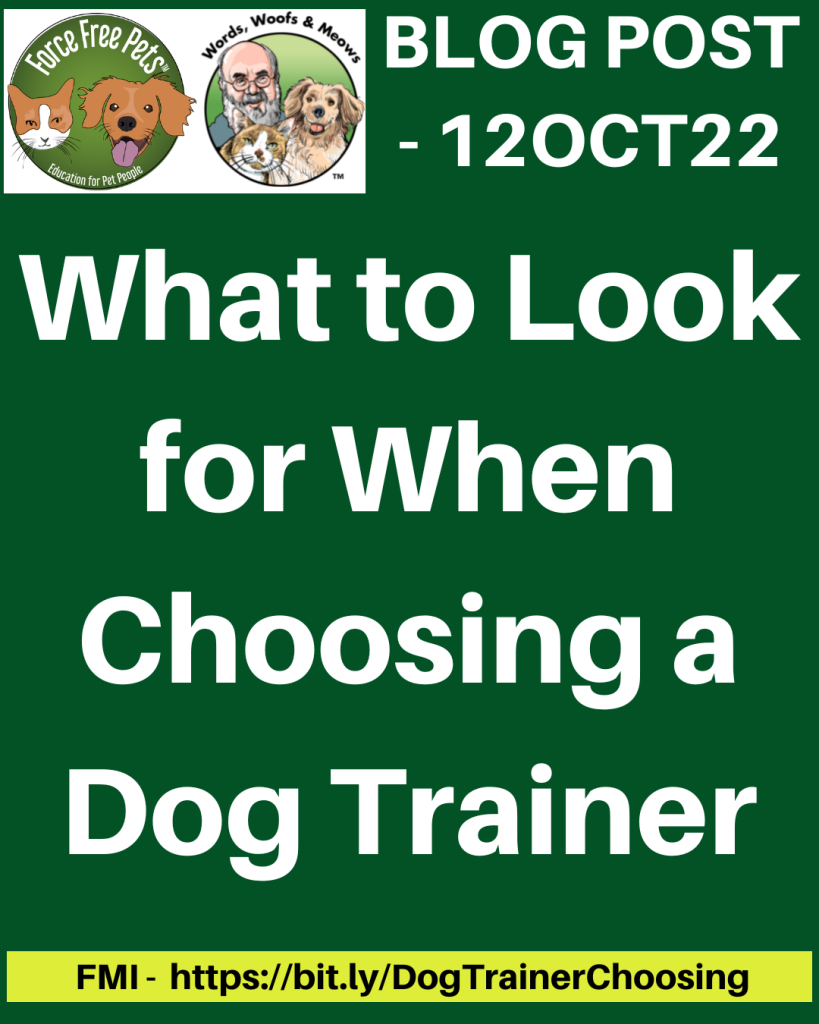 < Updated 12OCT22 >
< Updated 12OCT22 >
< A short link for this page – https://bit.ly/DogTrainerChoosing >
As someone who has been living with dogs since 1975 and teaching other people how to live happily with dogs since 1995, I can assure you that finding a good dog trainer, even before you get your puppy or dog, is every bit as important as finding the best veterinarian for your pet.
In the USA, dog training is currently an unlicensed profession. Therefore, there is no legal standard that a dog trainer must meet to demonstrate that they have the requisite knowledge, skills, and ethics to be a competent and humane trainer. It is essential to be cautious when selecting someone to work with your family; you,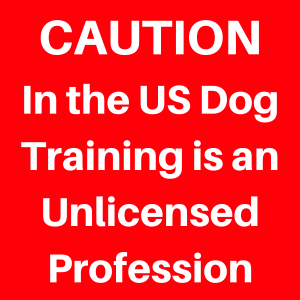 other adults, your children, if you have them, and your dog!
other adults, your children, if you have them, and your dog!
Below you will find criteria, in order of importance, that I suggest you use when selecting a dog trainer.
- Select a dog trainer that is knowledgeable on the latest professional research and standards in dog training and canine behavior, such as:
- the 2015 American Animal Hospital Association (AAHA) Canine and Feline Behavior Management Guidelines,
- the Pet Professional Guild (PPG) Guiding Principles, and
- the American Veterinary Society of Animal Behavior (AVSAB) Position Statement on Humane Dog Training.
The American Animal Hospital Association (AAHA), the Pet Professional Guild (PPG), and the American Society of Animal Behavior (AVSAB) recognize the danger posed by choosing the wrong dog trainer.
In the following excerpts from the 2015 American Animal Hospital Association Canine and Feline Behavior Management Guidelines, the AAHA explains the type of dog trainer one should avoid and the type one should choose.
“This Task Force opposes training methods that use aversive techniques.1 Aversive training has been associated with detrimental effects on the human–animal bond, problem-solving ability, and the physical and behavioral health of the patient. It causes problem behaviors in normal animals and hastens progression of behavioral disorders in distressed animals. Aversive techniques are especially injurious to fearful and aggressive patients and often suppress signals of impending aggression, rendering any aggressive dog more dangerous. 1
Aversive techniques include prong (pinch) or choke collars, cattle prods, alpha rolls, dominance downs, electronic shock collars, lunge whips, starving or withholding food, entrapment, and beating. None of those tools and methods should be used to either teach or alter behavior1. Nonaversive techniques rely on the identification and reward of desirable behaviors and on the appropriate use of head collars, harnesses, toys, remote treat devices, wraps, and 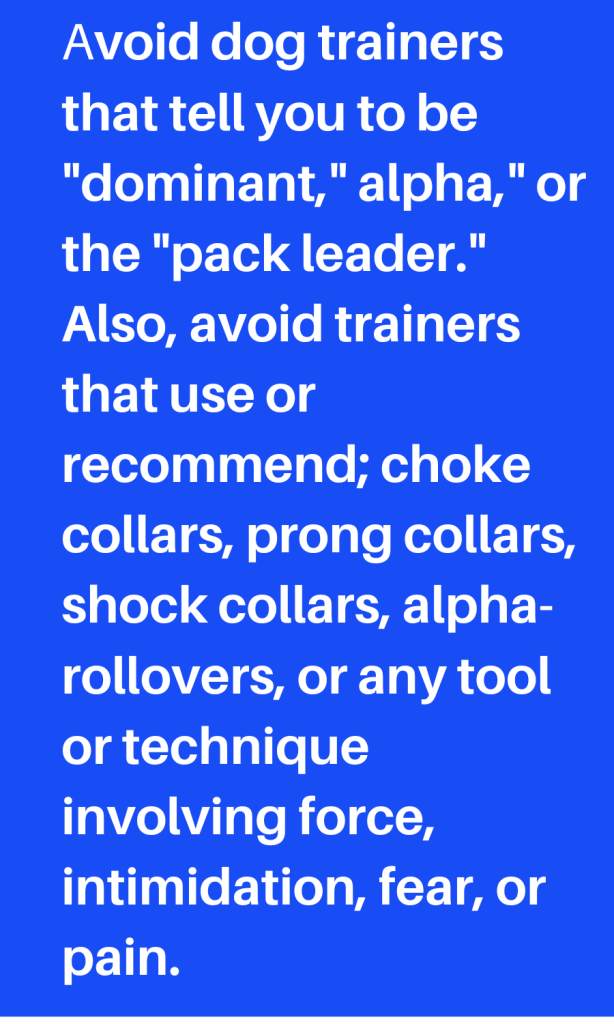 other force-free methods of restraint. This Task Force strongly endorses techniques that focus on rewarding correct behaviors and removing rewards for unwanted behaviors. “– [1 Emphasis Added]
other force-free methods of restraint. This Task Force strongly endorses techniques that focus on rewarding correct behaviors and removing rewards for unwanted behaviors. “– [1 Emphasis Added]
The Guiding Principles of the Pet Professional Guild state:
To be in anyway affiliated with the Pet Professional Guild all members must adhere to a strict code of conduct. Pet Professional Guild Members Understand Force-Free to mean: No shock, No pain, No choke, No fear, No physical force, No compulsion based methods are employed to train or care for a pet.1 The PPG Position Statement on the Use of Pet Correction Devices defines which training tools should and should not be used and explains why this is so important to your dogs quality of life. [1 Emphasis Added]
In the introduction to their Position Statement on Humane Dog Training, the American Society of Animal Behavior (AVSAB) states:
Evidence supports the use of reward based methods for all canine training. AVSAB promotes interactions with animals based on compassion, respect, and scientific evidence. Based on these factors, reward-based learning offers the most advantages and least harm to the learner’s welfare. Research supports the efficacy of reward-based training to address unwanted and challenging behaviors. There is no evidence that aversive training is necessary for dog training or behavior modification.
The application of aversive methods – which, by definition, rely on application of force, pain, or emotional or physical discomfort – should not be used in canine training or for the treatment of behavioral disorders. [1 Emphasis Added]
In summary, avoid dog trainers that tell you to be “dominant,” alpha,” or the “pack leader.” Also, avoid trainers that use or recommend; choke collars, prong collars, shock collars, alpha-rollovers, or any tool or technique involving force, intimidation, fear, or pain.
- Select a dog trainer that has demonstrated their knowledge and skills by being accredited by one of the following independent credentialing agencies:
While the government does not currently have licensing requirements for dog training and behavior professionals, two independent organizations within the profession have created a psychometrically sound examination process. That means the test applicants must pass has been developed by an independent body other than the organization that taught the individual being examined. Additionally, the examination meets industry standards for being a reliable, valid, and ethical assessment of the individual.
other than the organization that taught the individual being examined. Additionally, the examination meets industry standards for being a reliable, valid, and ethical assessment of the individual.
The Pet Professional Accreditation Board (PPAB) offers three credentials:
- Level 1 – Canine Training Technician (CTT-A)
- Level 2 – Professional Canine Trainer (PCT-A)
- Level 3 – Professional Canine Behavior Consultant (PCBC-A)
The PPAB offers the only Accredited Training Technician & Professional Canine Trainer certification for professionals who believe there is no place for shock, choke, prong, pain, force, or fear in pet training and behavior practices. They also offer the only psychometrically sound examination for Training & Behavior Consultants supporting these humane and scientific practices.
Personal Note from Don: For many years, I held credentials issued by organizations other than the PPAB. I have surrendered those credentials and am now credentialed by the PPAB. I did so because, at the time of this writing, the PPAB is the only credentialing agency in the USA that explicitly states that “…there is no place for shock, choke, prong, pain, force or fear in pet training and behavior practices.” as supported by the AAHA, PPG, and AVSAB documents noted above. [ FMI – https://bit.ly/DJH-PPAB ]
The Certification Council for Professional Dog Trainers (CCPDT) offers these credentials:
- Certified Professional Dog Trainer-Knowledge Assessed (CPDT-KA®)
- Certified Professional Dog Trainer-Knowledge and Skills Assessed (CPDT-KSA®)
- Certified Behavior Consultant Canine-Knowledge Assessed (CBCC-KA®)
A training facility may have some trainers on staff working towards their certification. Ideally, they should be under the direction of at least one certified professional. In the case of the PPAB and CCPDT, a professional dog trainer must be in a lead teaching position for a minimum of 300 hours before applying to take a certification exam.
It is essential to understand that there are many “certifications” available, and they are not all equal. The credentials mentioned above are all issued by independent organizations and require testing, compliance with ethical standards, and continuing education to maintain certification. A “certificate” from “Don’s School of Dog Training” or “The XYZ Dog College” is far from being equivalent to the credentials above.
Certification by one of the above organizations is NOT a guarantee that a dog trainer’s methods are free of the use of force, pain, or free. Always ask, and if you find that a dog trainer uses fear, force, or pain, find a different dog trainer.
- Select a dog trainer that is a member of at least one of these organizations; the Pet Professional Guild (PPG), or the Association of Professional Dog Trainers (APDT).
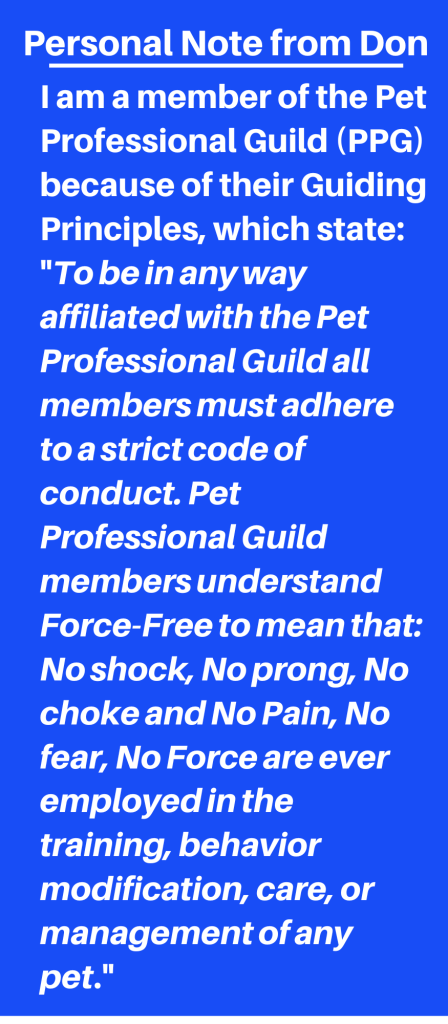 Dog training is a rapidly evolving profession, and those committed to it are members of these organizations to stay current in the field. The mentioned organizations offer a wide variety of continuing educational opportunities for pet care professionals; however, they have different ethical standards.
Dog training is a rapidly evolving profession, and those committed to it are members of these organizations to stay current in the field. The mentioned organizations offer a wide variety of continuing educational opportunities for pet care professionals; however, they have different ethical standards.
Personal Note from Don: I am a member of the Pet Professional Guild (PPG) because of their Guiding Principles, which state: “To be in any way affiliated with the Pet Professional Guild all members must adhere to a strict code of conduct. Pet Professional Guild members understand Force-Free to mean that: No shock, No prong, No choke and No Pain, No fear, No Force are ever employed in the training, behavior modification, care, or management of any pet.” I also serve on the Board of Directors for both PPG and PIAI.
- Look for dog trainers who treat people and dogs respectfully rather than with an “I am the boss” attitude. Remember, you will be the one being taught by this person. Professional dog trainers not only need to be able to train dogs, but they also need to be able to teach people of all ages to train their dogs. Therefore, classes should be such that you and your dog look forward to attending.
- Ask the instructor about their methods for teaching people. Do they provide comprehensive written materials? Do they demonstrate how to teach a behavior? Do they coach you as you practice with your dog? Are they available for questions outside of class? Not all people learn the same way. Training classes, whether private or group, should accommodate an individual’s learning style. Many training programs today also offer videos you can watch in the comfort of your home to supplement in-person learning. In the case of a puppy class, where most of the teaching focuses on the people, a virtual training program can be very effective.
- Look for classes with at least one instructor for every eight students. At Green Acres, our Basic Manners program is a semi-private class of two students and one instructor. A forty-five-minute lesson with 15 students and one instructor, not uncommon in the profession, leaves very little time for individual instruction.
- Avoid trainers who object to using food as a training reward. Food is an acceptable and highly effective positive reinforcement training tool. Just like us, our dogs do things because there is something in it for them, usually food.
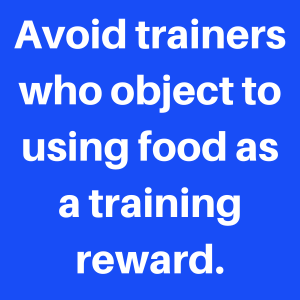 Research demonstrates that food is a better reinforcer for most dogs than play and touch. Praise typically has the lowest value as a reinforcer. If a trainer insists that dogs should work for praise only, ask him if you can take their classes for free if you tell him he is a fantastic trainer. You can be assured that your praise will not work in that scenario.
Research demonstrates that food is a better reinforcer for most dogs than play and touch. Praise typically has the lowest value as a reinforcer. If a trainer insists that dogs should work for praise only, ask him if you can take their classes for free if you tell him he is a fantastic trainer. You can be assured that your praise will not work in that scenario.
- Ask to observe a training class in-person or via video before enrolling. Are the dogs and people having a good time? Talk with a few participants and see if they are comfortable with the trainer’s methods. If a trainer does not let you observe a class, don’t enroll.
- Check references. Ask area veterinarians, animal shelters and rescues, boarding kennels, daycares, and groomers whom they recommend for training and why they recommend them. Check several references so that you know you are getting objective recommendations.
- Avoid trainers who offer guarantees about results. Trainers that guarantee results are either ignoring or do not understand the complexity of animal behavior. No living thing is one hundred percent predictable, and training a dog involves many variables that a dog trainer cannot control. These include your commitment level and compliance with the trainer’s In addition, most professional training organizations have a code of conduct or ethics statement that strongly suggests that trainers should not guarantee specific results.
- Ensure your dog trainer will take care to protect your dog’s health in a group setting. Ask if dogs and puppies in classes must be vaccinated before class and, if so, which vaccines are required. Make sure you and your veterinarian are comfortable with the vaccination requirements.
- The PPG suggests you ask any prospective trainer ten. I have reproduced these questions below and how we would answer them at ForceFreePets.
-
- What dog training equipment do you use when training a dog or do you recommend I use? – We recommend using a 6-foot leash, a regular flat collar or a front-connect or rear-connect harness, a treat bag, treats, and a clicker. We do not use choke, prong or shock collars or any equipment intended to punish, scare or hurt a dog in our classes, nor do we allow them their use at our facility.
- What happens in your training program when the dog responds in the way you want him to? – When a dog responds in a manner we desire, we reward the dog with food, a toy, or attention, something the dog likes. We remind people that the dog is often ignored when they are good and gets lots of attention when they are doing something we do not like. Make a point of looking for opportunities to reward your dog for being good.
- What happens in your training program when the dog responds in the way you do not want him to? – We teach you how to manage your dog and its environment to prevent undesirable behavior. We suggest that you ignore or redirect any behavior that occurs that you do not like as long as it is not dangerous to any living thing or could result in the destruction of something valuable. Paying attention to this “bad” behavior could be an unintentional reward to your dog, making it more likely to occur again. For example, if the dog jumps up on you and you push them off, saying “No,” you have just given the dog attention in three ways: touching them, looking at them, and speaking to them. Jumping on a person is often an attention-seeking behavior. If you did what I just described, you have rewarded it threefold. After the “bad” behavior is interrupted, you can look at ways to reward a mutually exclusive behavior or prevent the behavior from happening in the future.
- How will you punish the dog or advise me to punish the dog if he gets something wrong or exhibits a behavior I do not like? – We do not punish dogs for behavior because it is counterproductive. Instead, we focus on teaching you how to train and manage the dog to offer desirable behavior. Often people expect too much from a dog too soon, leading to frustration by both. That is why in addition to teaching you about training, we also teach you about normal and abnormal canine behavior, the importance of meeting your dog’s physical and emotional needs, and how to manage them and their environment to prevent behavior you do not like.
- How do you ensure that my dog is not inadvertently being punished? – All of our staff, not just the trainers, receive extensive training on canine communication, body language, and stress to ensure your dog is having a good time. We aim to have you and your dog love ForceFreePets and Green Acres Kennel Shop! If we see that a dog is feeling anxious or stressed, we will let you know and look for ways to help reduce their anxiety.
- How do you know that the type of reinforcement you have selected to train my dog is appropriate? – We have experience in using a wide variety of reinforcers to motivate your dog. We will start teaching you about reinforcers and how to choose the right one for a specific situation in class.
- How will you know or how will I know if my dog is stressed during the training? – Our entire staff is trained to look for signs of stress so that we can prevent it. Additionally, we do extensive training on canine body language and communication with all employees. We will also cover some of this material in our training classes. If you read our blog, you can find information on this topic that you can use at home. To read Canine Behavior – Understanding, Identifying, and Coping with Canine Stress <Click Here>
- Which professional dog training associations are you a member of? – All
 members of the Green Acres team, customer service, groomers, pet care technicians, trainers, and managers are enrolled as members of the Pet Professional Guild (PPG) as soon as they complete their employee training. Green Acres Kennel Shop is also an organizational member of Pet Industry Advocacy International and ForceFreePets. com is a member of PIAI through our membership with the PPG, a founding member of PIAI. PPG and PIAI require that we comply with ethical standards. You can read our policies here by < click here >
members of the Green Acres team, customer service, groomers, pet care technicians, trainers, and managers are enrolled as members of the Pet Professional Guild (PPG) as soon as they complete their employee training. Green Acres Kennel Shop is also an organizational member of Pet Industry Advocacy International and ForceFreePets. com is a member of PIAI through our membership with the PPG, a founding member of PIAI. PPG and PIAI require that we comply with ethical standards. You can read our policies here by < click here >
We encourage you to ask any pet care professional you are considering to provide you with a copy of their ethical code of conduct and associated policies and procedures.
-
- Will you guarantee your training results? – We do not guarantee training results because we are dealing with a living, breathing, sentient being. In reality, we cannot control all variables, including you and what you do at home. We are here to give you all the support we can, but you live and work with your dog for far more hours per week than we do, so you will significantly influence how well your dog does with training.
- How do you think a dog’s behavior should be addressed if the dog is growling or snapping at people or other dogs? – Safety for all the people and dogs in our classes is our first concern. If your dog has a history of growling and snapping at people, please let us know before you enroll in a group class, as that may cause your dog’s aggressive behavior to get worse. If your dog is growling or snapping at people outside of class, talk to your veterinarian and us as soon as possible. Growling is often the result of fear, and it is something we can help you with through our behavior consulting services < FMI – Click Here > For more information on growling, read Canine Behavior – What Should I Do When My Dog Growls? < FMI – Click here >
Recommended Resources
What Is Dog Training? – http://bit.ly/WhatIsDogTraining
Do I Need a Dog Trainer or a “Behaviorist”? – http://bit.ly/WWM-Trainer-Behaviorist
What Is A Pet Behavior Consultant? – http://bit.ly/WhatIsPetBhxConsulting
Help! My Dog Is Stubborn! – https://bit.ly/HelpStubborn
There Are No “Stubborn” Dogs – Twelve Steps to Becoming Best Friends for Life – https://bit.ly/12Steps-BestFriendsForLife
Dog Training – A Rescue Dogs Perspective – http://bit.ly/Rescue-Muppy
Reward Based Training versus Aversives – http://bit.ly/RewardVSAversive
What Is Clicker Training? – http://bit.ly/WhatIsClickerTraining
Helping your dog thrive with Brambells Five Freedoms – http://bit.ly/Brambell-1thru5-PDF
Help! My Dog is Aggressive, Reactive, Fearful, Anxious, etc. – What do I do? – http://bit.ly/HelpDogAggx
How Can I Tell When My Dog Is Anxious or Fearful? – http://bit.ly/DogsSignsofFear
Essential Handouts On Body Language, and Canine and Human Behavior from Dr. Sophia Yin – https://bit.ly/YinBodyLang
Understanding, Identifying and Coping with Canine Stress – http://bit.ly/Canine-Stress
About Don Hanson – https://blog.greenacreskennel.com/about-the-author-don-hanson/
________________________________________________________________________
Don Hanson lives in Bangor, Maine, where he is the co-owner of the Green Acres Kennel Shop ( greenacreskennel.com ) and the founder of ForceFreePets.com, an  online educational resource for people with dogs and cats. He is a Professional Canine Behavior Consultant (PCBC-A) accredited by the Pet Professional Accreditation Board (PPAB) and a Bach Foundation Registered Animal Practitioner (BFRAP). Don is a member of the Pet Professional Guild (PPG), serving on the Board of Directors and Steering Committee and chairing the Advocacy Division. He is also a founding director of Pet Advocacy International (PIAI). In addition, Don produces and co-hosts The Woof Meow Show podcast, available at http://bit.ly/WfMwPodcasts/, the Apple Podcast app, and Don’s blog: www.words-woofs-meows.com. The opinions in this article are those of Don Hanson.
online educational resource for people with dogs and cats. He is a Professional Canine Behavior Consultant (PCBC-A) accredited by the Pet Professional Accreditation Board (PPAB) and a Bach Foundation Registered Animal Practitioner (BFRAP). Don is a member of the Pet Professional Guild (PPG), serving on the Board of Directors and Steering Committee and chairing the Advocacy Division. He is also a founding director of Pet Advocacy International (PIAI). In addition, Don produces and co-hosts The Woof Meow Show podcast, available at http://bit.ly/WfMwPodcasts/, the Apple Podcast app, and Don’s blog: www.words-woofs-meows.com. The opinions in this article are those of Don Hanson.
©12OCT22, Donald J. Hanson, All Rights Reserved
< Click for Copyright and Use Policy >
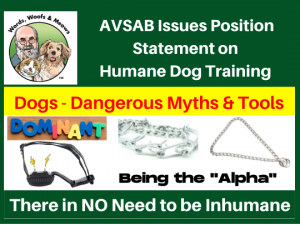 < A version of this article was published in the OCT 2021 issue of Downeast Dog News>
< A version of this article was published in the OCT 2021 issue of Downeast Dog News> familiarize themselves with the position statement and the cited studies. This is information they MUST be familiar with to practice ethically. The position statement refutes many myths about dogs, their behavior, and training, such as dominance, pack hierarchy, and the need to be “alpha.” AVSAB concludes its statement with the following:
familiarize themselves with the position statement and the cited studies. This is information they MUST be familiar with to practice ethically. The position statement refutes many myths about dogs, their behavior, and training, such as dominance, pack hierarchy, and the need to be “alpha.” AVSAB concludes its statement with the following: treatment of behavior problems. Aversive training methods have a damaging effect on both animal welfare and the human-animal bond. There is no evidence that aversive methods are more effective than reward-based methods in any context. AVSAB therefore advises that aversive methods should not be used in animal training or for the treatment of behavior disorders.” [emphasis added]
treatment of behavior problems. Aversive training methods have a damaging effect on both animal welfare and the human-animal bond. There is no evidence that aversive methods are more effective than reward-based methods in any context. AVSAB therefore advises that aversive methods should not be used in animal training or for the treatment of behavior disorders.” [emphasis added]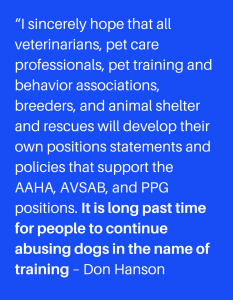 best way to achieve that goal is with rewards, not punishment. I genuinely believe that no one with a dog wants to hurt their dog. If you or your trainer cannot get results without punishment, step back and recognize it’s time for you to learn a better way. Many trainers can help you get the results you want without resorting to aversives.
best way to achieve that goal is with rewards, not punishment. I genuinely believe that no one with a dog wants to hurt their dog. If you or your trainer cannot get results without punishment, step back and recognize it’s time for you to learn a better way. Many trainers can help you get the results you want without resorting to aversives.

